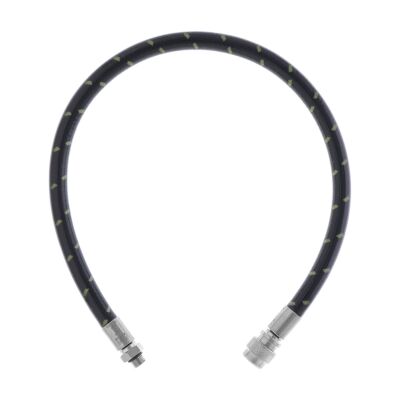BC Inflator Miflex XT-Tech Hose
- Similar characteristics of traditional rubber hose yet benefits of a braided flex hose
- Smooth polyurethane outer surface reduces abrasion
- Braided layer includes Kevlar® yarn reinforcement
- Negative buoyancy - Lighter in weight than traditional rubber hoses
- Fittings are marine grade nickel plated brass
BC Inflator Miflex XT-Tech Hose
The multi-layer design of the Miflex XT-Tech hose has a polyether based thermoplastic inner liner, fiber braiding of polyester & Kevlar® and an outer smooth layer of thermoplastic. The Miflex XT-Tech hose is negatively buoyant, allowing the hose to stay in place with less abrasion.
- Inner lining is made from polyether based polyurethane
- Braided layer includes Kevlar® yarn reinforcement
- Smooth polyurethane outer surface reduces abrasion
- Negative buoyancy allow the hoses to stay in place
- Lighter in weight than traditional rubber hoses
- Fittings are marine grade electroless nickel plated brass
- 100% leak tested and produced on fully automated assembly lines
MIflex XT-Tech low-pressure BC hoses are currently available in a limited number of lengths with standard 3/8-inch male first stage and standard slide-lock Schrader valve quick disconnect fittings. All Miflex hoses are certified to conform to the CE EN250 standard and Nitrox Ready. All Miflex XT-Tech hoses are supplied in re-usable dry bag packaging, complete with manufacturers user and warranty information.
| Brand | XS Scuba |
|---|---|
| SKU | MF-MXTQDxx |
| Weight | 0.500000 |
Customer Reviews
 WARNING
WARNING
Keep in mind that all hoses will fail sooner or later either due to age, storage conditions or handling. Scuba hoses, regardless of brand and materials, require some minimal care. Do not allow hoses to receive prolonged exposure sunlight, as the heat and UV from strong sunlight will significantly shorten the life of the hose. Do not attempt to flush the inside of the hose with any form of solvent or other chemical, new hoses are factory clean and if you have any reason to think they are no longer clean then the hose should be replaced. Prior to every dive trip you should always pressurize and inspect your hoses for mechanical damage, corroded fittings, bulges and leaks. Dive Gear Express suggests replacing all SCUBA regulator hoses every five years of service or 500 dives, whichever comes first.
Choosing the Best Inflation Hose Length
For BC power inflator hoses with the ordinary quick-disconnect Schrader fitting, the most common length seen on the 'jacket' style BC is {26 in | 66 cm} or {28 in | 71 cm} because the large-diameter corrugated hose length is relatively long and most sport first stage regulators are 'fixed' port orientations which can result in less than optimal hose routing. Our observation of divers in the water is these one-length-fits-all hoses are often too long, causing the hose to 'bow' out and the inflator assembly to lay at an inconvenient or improper location with the resulting increase in drag. Using a shorter BC hose is particularly beneficial if the diver has added a powered alert whistle inline with the BC power-inflator.
For divers using back inflation, the typical length seen on the 'wing' style BC is {22 in | 56 cm} because the large-diameter corrugated hose is usually a little shorter on wings. This length generally works well on singles where the regulator first stage has swivel ports and on doubles where the hose will coming off the 5th port of the divers right post regulator. Some cave divers prefer a short corrugated hose where the inflator rests at their shoulder rather than their chest, and the BC power-inflator hose is typically {18 in | 46 cm} long. We don't have a recommendation for sidemount divers as the lengths are very sensitive to the configuration, but the {15 in | 38 cm} length is popular and we even see some sidemount rigs using {9 in | 23 cm} hoses, although with short hoses A-framing can be an issue.
BC integrated backup second stages are a special case and require a hi-flow quick coupling. You can not use a standard BC inflator QD hose Schrader fitting to supply a BC integrated alternate air source, as the device would not receive enough gas due to the flow restriction of a standard Schrader fitting. To replace the hose for one of these devices, you will need to use a {26 in | 66 cm} LP regulator hose plus a BC Integrated 2nd Stage Adapter.
Most drysuit inflation systems use the same fitting as found on BCs, but need a longer length. For drysuit divers, where the hose routes under their arm to a chest mounted power-inflator, the typical length is {30 in | 76 cm} or sometimes {36 in | 91 cm} depending on the locations of the power-inflator relative to the first stage supply. We've also seen some drysuit inflation systems which relied upon a special flow-restrictor orifice in the first stage fitting of the hose rather than in the inflator valve itself and while the drysuit inflator hose appears to be the same as an ordinary BC inflator hose, it is not the same. You should consult the manual that came with your drysuit to be certain your drysuit inflator valve can use a standard BC inflator hose.
Finally, we sometimes hear from someone seeking a BC hose for the backup power-inflator of their redundant bladder wing. There is controversy regarding the use of dual bladder wings, and we won't join the debate here. However, rapidly diagnosing a dribbling or runaway power-inflator plus other issues introduced by an additional BC inflation hose, leads some experienced divers who choose to dive with redundant bladder wings to avoid connecting the backup power-inflator. Instead the backup BC is only inflated orally in an emergency.

